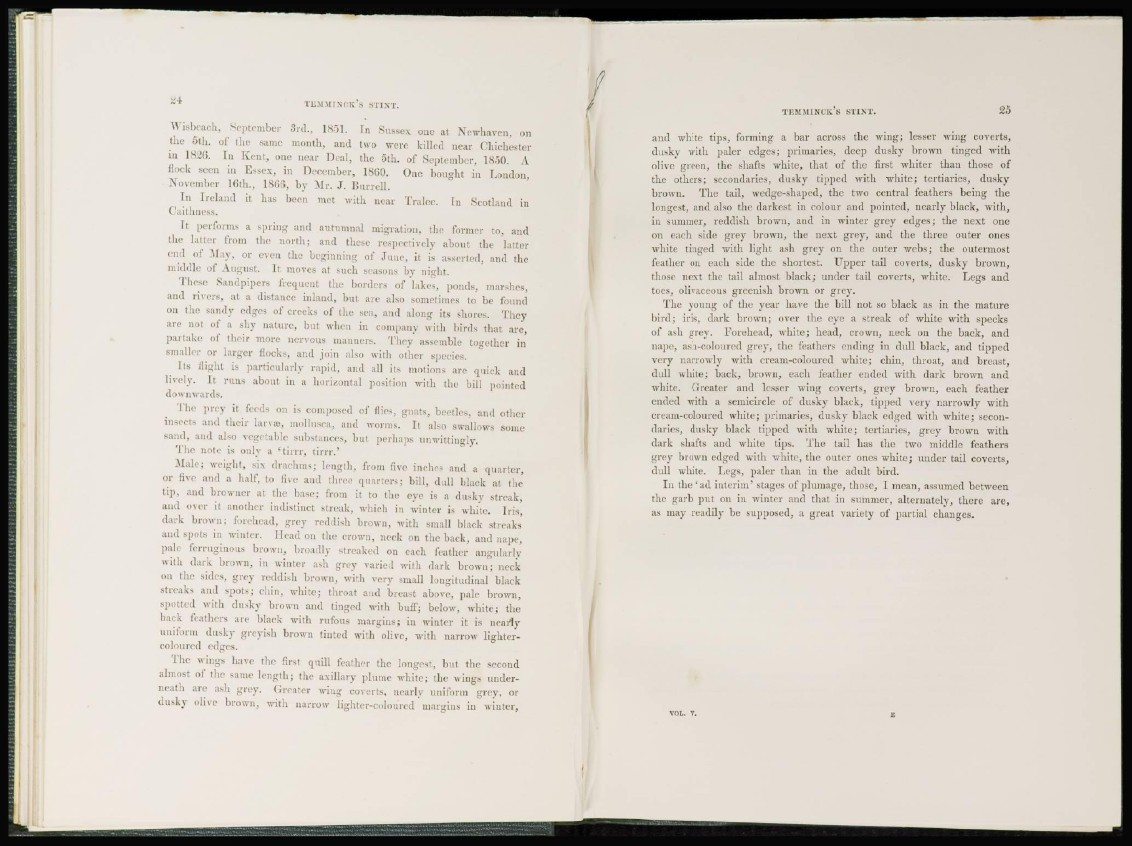
TEMM1 NCR's MINT.
Wisbeach, September 3rd., 1851. In Sussex one at Nowhaven, on
t h e 5th. of the same month, and two were killed near Chichester
in 1826. In Kent, one near Deal, the 5th. of September, 1850. A
flock seen in E-scx, in December, I860, One bought in London,
November 16th., 1866, by Mr. J . Burrell.
In Ireland it has been met with near Tralee. In Scotland in
(laithness.
I t performs a spring and autumnal migration, the former to, and
the latter from the north; and these respectively about the latter
end of May, or even the beginning of June, it is asserted, and the
middle of August. It moves at such seasons by night.
These Sandpipers frequent the borders of lake-, ponds, marshes,
a n d rivers, at a distance inland, but are also sometimes to be found
on the sandy edges of creeks of the sea, and along its shores. They
are not of a shy nature, but when in company with birds that are,
p a r t a k e of their more nervous manners. They assemble together in
•mailer or larger flocks, and join also with other species.
I t s flight is particularly rapid, and all its motions are quick and
lively. It runs about in a horizontal position with the bill pointed
downwards.
The prey it feeds on is composed of flies, gnats, beetles, and other
insects and their larva), mollusca, and worms. It also swallows some
sand, and also vegetable substances, but perhaps unwittingly.
T h e note is only a ' t i r r r , t i r r r .'
Male; weight, six drachms; length, from five inches and a quarter,
or five and a half, to five and three q u a r t e r s ; bill, dull black at the
t i p , and browner at the base; from it to the eye is a dusky streak,
and over it another indistinct streak, which in winter is white. Iris,
d a r k brown; forehead, grey reddish brown, with small black streaks
and spots in winter. Head on the crown, neck on the back, and nape,
pale ferruginous brown, broadly streaked on each feather angularly
with dark brown, in winter ash grey varied with dark browu; neck
on the s i d e s , grey reddish brown, w i t h very small longitudinal black
streaks and spots; chin, white; throat and breast above, pale brown,
spotted with dusky brown and tinged with buff; below, white; the
back feathers are black with rufous margins; in winter if is nearly
uniform dusky greyish brown tinted with olive, with narrow lightercoloured
edges.
The wings have the first quill feather the longest, but the second
almost of t h e same l e n g t h ; the axillary plume wdiite; the wings underneat
li Lire ash grey. (i reater wing coverts, nearly uniform grey, or
dusky olive brown, with narrow lighter-coloured margins in winter,
TEMMINCK S STINT. 25
a n d white tips, forming a bar across the wing; lesser wing coverts,
dusky with paler edges; primaries, deep dusky brown tinged with
olive green, the shafts white, that of the first whiter than those of
the others; secondaries, dusky tipped with white; tertiaries, dusky
brown. The tail, wedge-shaped, the two central feathers being the
longest, and also the darkest in colour and pointed, nearly black, with,
in summer, reddish brown, and in winter grey edges; the next one
on each side grey brown, the next grey, and the three outer ones
white tinged with light ash grey on the outer webs; the outermost
feather on each side the shortest. Upper tail coverts, dusky brown,
those next the tail almost black; under tail coverts, white. Legs and
toes, olivaceous greenish brown or grey.
The young of the year have the bill not so black as in the mature
bird; iris, dark brown; over the eye a streak of white with specks
of ash grey. Forehead, white; head, crown, neck on the back, and
nape, ash-coloured grey, the feathers ending in dull black, and tipped
very narrowly with cream-coloured white; chin, throat, and breast,
dull white; back, brown, each feather ended with dark brown and
white. Greater and lesser wing coverts, grey brown, each feather
ended with a semicircle of dusky black, tipped very narrowly with
cream-coloured white; primaries, dusky black edged with white; secondaries,
dusky black tipped with white; tertiaries, grey brown with
dark shafts and white tips. The tail has the two middle feathers
grey brown edged with white, the outer ones white; under tail coverts,
dull white. Legs, paler than in the adult bird.
I n the ( a d i n t e r i m ' stages of plumage, those, I mean, assumed between
the garb put on in winter and that in summer, alternately, there are,
as may readily be supposed, a great variety of partial changes.
VOL. V.